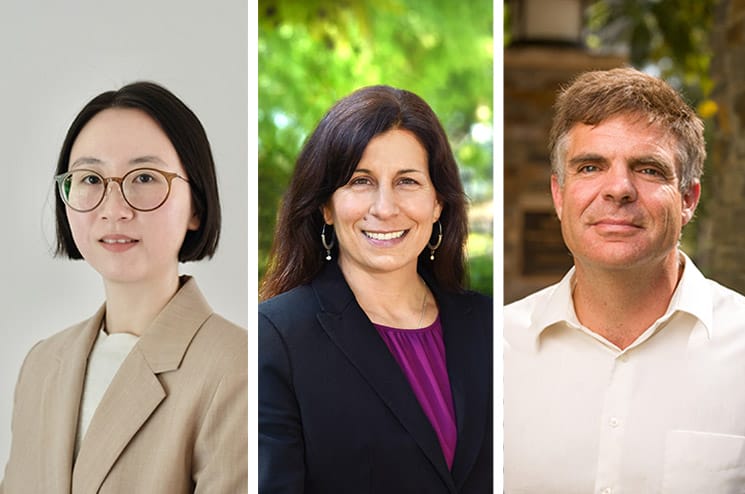Applying a Mathematical Language to the Pandemic

In her wildest imagination, it never occurred to Yujia Ding that crunching numbers could lead her to work on one of the biggest problems vexing the world right now—the COVID-19 pandemic.
Ding, a doctoral student in the university’s Institute of Mathematical Sciences (IMS), has been working with Professors Henry Schellhorn and Nicole Gatto on two modeling papers about COVID-19 with potential real-world applications.
“I never thought I’d be working on a problem this big,” said Ding, who came to the U.S. from China in 2013.
Her previous work with a real-life problem involved a project on cell phone authentication and trying to find ways to protect people from having their phones hacked.
“I was a tiny part of a super-big project,” she said. “Everyone is so worried now to get hacked because their whole lives are stored in their phones.”
Finding a way to optimally fight the global pandemic.
Even though an estimated 80% of the world population uses smartphones today, that project still slightly pales in comparison to the scale of the pandemic and vaccine distributions that remain uneven and uncertain (and tangled in the U.S. with a tremendous amount of political tension and anger on the pro-vaccine and anti-vaccine sides).
The modeling project that Ding has been collaborating on with Schellhorn and Gatto—Schellhorn is an IMS faculty member who also directs the Drucker School’s Financial Engineering program; Gatto is a faculty member of the university’s School of Community and Global Health—involves using a mathematical model to identify an optimal situation for the application of vaccines.
A year ago, Schellhorn sent out an email inviting anyone in the math program to participate in this research and Ding jumped at the opportunity.
“It was very exciting to me and a rare occurrence to work with both professors,” Ding said. “That was a big reason why I really wanted to join the team. When I’m learning math, I want to do something real with it. I want to take my math studies, if I can, out of the theoretical and into the practical; and I think this modeling is a great opportunity to do that.”
A Formula to Fight Covid-19
Ding says her research work with Schellhorn and Gatto is in a “mathematical language” and not very explicit in real-world terms—yet. Even though “it’s still theoretical,” she says, it may provide benefits later on.
While the goal of the modeling project—to identify the conditions under which the fight against COVID-19 can be waged most optimally—is obviously important, Schellhorn added that their methodological approach deserves attention, too.
“We found formulae for the optimal solution, as opposed to other researchers who develop numerical methods,” he explained. “There is a big trend nowadays (mostly among students who do not like math) to ask the question: what is the point of developing a formula when computers with artificial intelligence can do it for us?”
Ding says she wants to take her math studies “out of the theoretical and into the practical.”
To answer that, Schellhorn points to a moment considered a turning-point in artificial intelligence: The victory of Deep Blue, a chess-playing supercomputer created by IBM, in 1997 over world chess master Garry Kasparov.
“When IBM’s Deep Blue defeated him,” Schellhorn said, “it was hailed as the moment when artificial intelligence trumped natural intelligence. A game of chess requires on average 10^120 operations (1 followed by 120 zeroes). The problem we solved has potentially 10^47000 solutions. This means that we would need 10^46880 computers to solve this problem. We do not have them. In my opinion, this is still a case in which natural intelligence trumps artificial intelligence.”
A Life with Numbers
Ding grew up in the city of Xi’an, a province in Central China. The city, one of the oldest in China, has a population of more than 12 million and is famous as the site of the Bingmayong (terra cotta army) of thousands of life-size, hand-molded figures buried with China’s first emperor, Qin Shi Huang. In Xi’an, Ding double-majored in financial engineering and applied mathematics.
“I guess I’ve always been pretty proficient with numbers,” laughed Ding, who earned a master’s degree at the Drucker School in Financial Engineering. “I get the knack from my family for that kind of logic. My mother and father are both PhD’s in engineering, so, I guess they’re my mathematical influence.”
“I decided to go with math for my PhD after I got my master’s degree,” Ding continued. “I was actually talking to Professor Schellhorn about the direction for my PhD. I think he thought I had some talent in mathematics. I got lots of encouragement from him, and so I made a kind of snap decision at that moment.”
Ding came to CGU after doing an online search for a graduate school.
“I was attracted because I wanted to be at a college with smaller-sized classes where the ratio of students to professors isn’t overwhelming,” she said. “I wanted to be closer to faculty and be able to build relationships with them and have more opportunity to communicate with students. That was the biggest selling-point to me when I was choosing schools.”
Another added benefit, according to Ding, is that the five Claremont Colleges are all within walking distance of the IMS.
“I get lots of support and help from the faculty of my department at the institute,” she said. “It’s a very friendly environment. I can take whatever classes I’m interested in from one of the 5C’s and I can take classes from other departments within CGU. I can look for collaborators on my own and build my own path. I’ve been encouraged to try everything that I want to try.”
For Ding, ideally, her post-doctoral future will lead her into the world she enjoys most, research.
“I just want to keep learning and apply mathematics to more popular modeling problems,” she said.